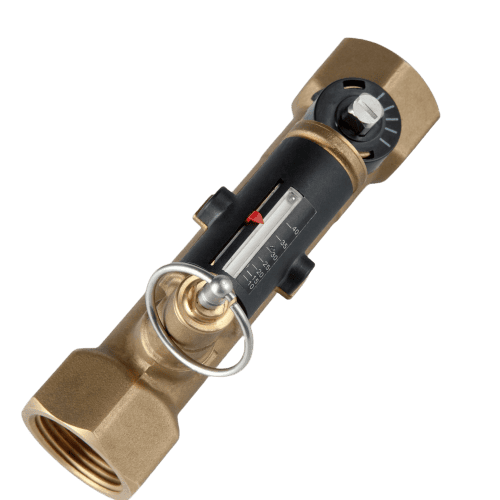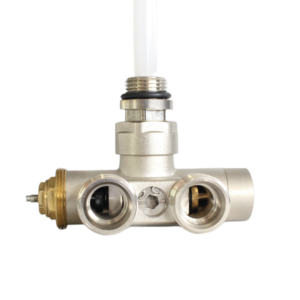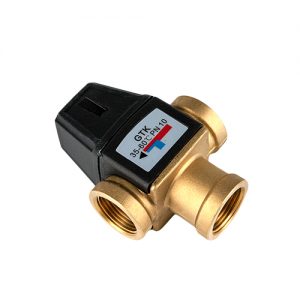Description
Brass Balancing Valve with Flow Meter
JX-0943
The temperature of Media: Medium Temperature
Power: Hydraulic
Media: Water
Port Size:1/2~1-1/4
Structure: Shutoff
Medium: water, glycol solutions
Max. percentage of glycol:50%
Working temperature range:-10~110°C
Waterflow rate of measurement:l/min
Accuracy:±10%
Control stem angle of rotation:90°
Benefits;
The Brass balancing valve is a hydraulic device that accurately regulates heating. The water flow rate of the heating system is supplied to the system terminals. The proper water balancing of hydraulic systems is essential to guarantee their operation according to their drawing design specifications, high thermal comfort, and low energy consumption. This particular series of valves has a flow meter to read the regulated water flow rate directly. It is housed in a bypass circuit on the valve body. It can shut off the valve during normal functioning, allowing the fast and easy balance of the mixing water of courses without differential pressure gauges. The valve is equipped with hot pre-formed shell insulation to ensure perfect thermal performance in case of using cold or boiling water.

A brass balance valve with a flow meter is perfect for regulating the water flow in your plumbing system. This valve helps to ensure that you have just the right amount of water flowing through your pipes, which can help to keep your system running smoothly. It also includes a handy flow meter to track water usage in your home quickly. With this brass balance valve, you can maintain optimal water pressure and flow in your plumbing system. The brass balance valve with a flow meter is perfect for regulating the water flow in your pipes. It ensures a consistent and accurate water flow, especially for commercial and industrial applications. With its durable brass construction, this valve will last for years. And with its built-in flow meter, you can easily track the water flowing through your system.
Its precision instrument allows you to adjust the water flow through your plumbing system. It also includes a built-in flow meter to monitor the water passing through the valve. This handy tool ensures that your plumbing system runs at peak efficiency. With this valve, you can fine-tune the water pressure and ensure that your home uses only the water it needs. The brass balance valve with a flow meter is essential for any well-functioning plumbing system.
This balance valve with a flow meter is the perfect way to balance your water system. The valve measures and regulates the flow of water to have the right amount of pressure, regardless of how many fixtures are used. The included flow meter lets you easily track how much water passes through the valve. This helps to prevent any unexpected changes in pressure or flow. Installation is easy and can be set up in minutes – no special tools are required! Keep your water system running smoothly with this handy brass balance valve.
A balance valve with a flow meter is essential for any plumber or HVAC technician. The valve allows you to adjust the water flow in a system and measure it accurately. The flow meter ensures an accurate reading, essential for troubleshooting and diagnostics. This tool is made of durable brass to withstand the wear and tear of daily use. It is also easy to install, so you can be up and running quickly. Ensure you have this essential tool for your next plumbing or HVAC project.
The brass balance valve, often nestled inconspicuously within plumbing networks, plays a pivotal role in ensuring systems run smoothly and efficiently. Brass, with its inherent properties, makes these valves resilient and dependable. In this comprehensive guide, we’ll explore the nuances of brass balance valves, shedding light on their operation, application, and benefits.
Introduction to the Balance Valve
The balance valve, formally known as the balancing valve, is a specialized valve designed to regulate and balance water flow across a plumbing or heating system.
History and Evolution:
Balance valves are not a modern innovation. Their conception can be traced back to when centralized heating systems began to gain popularity. Over time, as systems became more intricate, the need to ensure equal water distribution grew apparent, leading to the development of the modern balance valve.
Design Specifics:
The design of a balance valve is centered on its core functionality – to modulate. Typically, it will have a manual lever or an automated system that can adjust the flow rate. The valve might also feature a built-in meter or gauge to give real-time feedback on flow rates.
The Role of Differential Pressure:
The concept of differential pressure is central to the operation of a balance valve. This is the difference in pressure between two points in a system. The balance valve uses this differential pressure to decide how much to open or close, ensuring each part of the system gets the right amount of water.
The Significance of Brass
The world of metals offers an array of choices for manufacturing. However, brass stands out for several compelling reasons when balancing valves.
Composition and Properties:
Brass is a blend of copper and zinc. This combination imbues brass with a golden sheen and, more importantly, a set of physical properties making it perfect for plumbing. It’s neither hard nor soft, offering just the right level of malleability.
Why Not Other Metals?
Metals like iron can rust; others might corrode when exposed to certain water types. Brass, however, boasts superior corrosion resistance, vital for components constantly in contact with water.
Environmental and Health Benefits:
Brass is lead-free, ensuring the water passing through is not contaminated with harmful substances. Moreover, being a non-ferrous metal, brass is non-magnetic, which can be advantageous in specific applications.
How Does a Brass Balance Valve Work?
Understanding the mechanics of a balance valve can offer insights into its significance.
Dynamic Balancing:
A balance valve constantly adjusts based on real-time conditions. It reacts to changes in pressure, ensuring that even if one part of a system is drawing more water, other areas aren’t left high and dry.
Static vs. Dynamic:
While a static balance valve is set to a predetermined position during system setup and remains unchanged, a dynamic balance valve continually adjusts. The brass construction ensures that these adjustments, which could be frequent, don’t wear the valve out prematurely.
From Caleffi Hydronic Solutions
Key Applications
Brass balance valves have found their place in a myriad of domestic and industrial systems.
Residential Applications:
From underfloor heating systems to domestic hot water recirculation systems, balance valves ensure each room or tap receives an equal share of the water pie.
Industrial Scenarios:
In larger buildings like hotels or offices, balance valves are pivotal in ensuring that the top floors receive as much water with the same pressure as the lower ones.
Specialized Uses:
In systems where temperature matters, such as in specific manufacturing processes or scientific research labs, balance valves maintain consistency, ensuring functions remain uncompromised.
Installation and Maintenance
While these valves are sturdy thanks to their brass construction, proper installation and maintenance are keys to their longevity.
Selecting the Right Valve:
Before installation, choosing the correct valve based on system requirements is essential. Factors like maximum flow rate, system pressure, and connection type all play into this decision.
Installation Best Practices:
Ensuring that the valve is accessible for future maintenance, keeping it away from extreme heat sources, and ensuring it’s oriented correctly (based on the manufacturer’s guidelines) are crucial steps.
Routine Checks:
Maintenance for brass balance valves isn’t particularly demanding. Regular checks for debris any signs of wear, and ensuring the valve moves freely if it’s a manual type are usually enough.
Conclusion
With its historical significance and modern relevance blend, the brass balance valve remains a cornerstone of inefficient plumbing systems. Whether you’re designing a new system or looking to upgrade an existing one, understanding these valves can be the difference between a smoothly running system and one riddled with inefficiencies.







